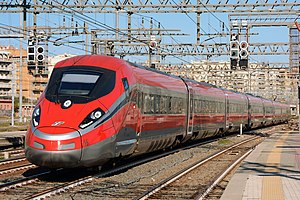| Frecciarossa 1000 | |
|---|---|
 | |
| Manufacturer | Hitachi Rail Italy (sole constructor from 2021)[a] electric motors from Alstom Trápaga[1] |
| Designer | Mike Robinson[2] and Bertone |
| Built at | Pistoia (Hitachi Rail Italy) AnsaldoBreda ; Vado Ligure (Bombardier Italy) |
| Family name | ETR 1000 (IT), Serie 109 (ES), commercial Frecciarossa 1000 |
| Constructed | 2013–present |
| Entered service | from 2015 |
| Number under construction | 14 (ordered), 23 (optional)[3] |
| Number built | 50[4](1 out of service, damaged in Livraga derailment on 6 February 2020) |
| Formation | 4M4T; 1 Executive car, 1 Business car, 1 Business car with a bar-bistro, 1 Premium car, 4 Standard cars. |
| Capacity | 457 (Executive, 10; Business, 69; Premium, 76; Standard, 300; and wheelchair, 2)[5] |
| Operators | Trenitalia Iryo |
| Lines served |
|
| Specifications | |
| Car body construction | Aluminium alloy |
| Train length | 202 m (662 ft 9 in) |
| Width | 2,924 mm (9 ft 7.1 in) |
| Height | 4,080 mm (13 ft 5 in) |
| Floor height | 1,240 mm (49 in) |
| Doors | 28 (total) |
| Wheel diameter | 920 mm (36 in) |
| Maximum speed | |
| Weight | 500 t (490 long tons; 550 short tons) |
| Axle load | 17 t (17 long tons; 19 short tons) |
| Traction system | Water-cooled IGBT–VVVF inverter control |
| Traction motors | 16 × 3-phase AC induction motor |
| Power output | 9,800–10,000 kW (13,100–13,400 hp) |
| Tractive effort | 370 kN (83,000 lbf) |
| Acceleration | 0.7 m/s/s (1.6 mph/s) |
| Deceleration | 1.2 m/s/s (2.7 mph/s) |
| Electric system(s) | 25 kV 50 Hz AC, 15 kV 16+2⁄3 Hz AC (installed, but not active), 3 kV DC, 1,500 V DC overhead catenary |
| Current collector(s) | Pantograph |
| UIC classification | Bo′Bo′+2′2′+Bo′Bo′+2′2′+2′2′+Bo′Bo′+2′2′+Bo′Bo′ |
| Braking system(s) | Regenerative, dynamic, electro-pneumatic |
| Safety system(s) | ERTMS, ETCS, SCMT, ASFA, LZB |
| Track gauge | 1,435 mm (4 ft 8+1⁄2 in) standard gauge |
| Notes/references | |
| Sources:[8][9] | |
The Frecciarossa 1000[10][11][12][13] is a high-speed train operated by Italian state railway operator Trenitalia and the private Spanish high-speed rail operator Iryo. It was co-developed as a joint venture between Italian rail manufacturer Hitachi Rail Italy (initially AnsaldoBreda) and multinational conglomerate Alstom (initially Bombardier Transportation). Both design and production work were divided between the two partner companies.
Design work on the train began in 2008, with considerable design work performed by Mike Robinson[2] and Bertone. It was heavily based on existing products, including Bombardier's Zefiro and AnsaldoBreda's V250 trains. The design was modified to conform with the requirements of the Trenitalia tender. In 2010, the Frecciarossa 1000 was selected and a total of 50 trainsets were ordered to meet Trenitalia's needs. Upon the public unveiling of the first example of the type, it was hailed as being the fastest train to reach series production in Europe at that time.[14]
Cite error: There are <ref group=lower-alpha> tags or {{efn}} templates on this page, but the references will not show without a {{reflist|group=lower-alpha}} template or {{notelist}} template (see the help page).
- ^ "Spagna: ILSA, il primo operatore privato per AV ferroviaria avvia test per ETR1000 sulla linea Figueras-Perpignan" (Press release) (in Italian). FerPress. 7 September 2021. Retrieved 10 March 2023.
- ^ a b "Michael Robinson | LinkedIn". linkedin.com. Retrieved 20 July 2023.
- ^ "Hitachi and Bombardier awarded contract to supply 23 very high-speed Frecciarossa trains to Trenitalia for operation by ILSA on routes in Spain" (PDF) (Press release). Hitachi. 10 August 2020.
- ^ "Industrial Plan 2017 – 2026". fsitaliane.it. Archived from the original on 3 July 2017. Retrieved 23 January 2017.
- ^ "Frecciarossa 1000 roadshow". leonardocompany.com. Leonardo-Finmeccanica. Retrieved 6 July 2016.
- ^ "Frecciarossa 1000, Trenitalia High Speed trains speeding toward the future". Ferrovie dello Stato Italiane.
- ^ "Frecciarossa 1000". Finmeccanica. Archived from the original on 20 June 2015. Retrieved 3 September 2014.
- ^ "FRECCIAROSSA 1000" (PDF), www.fsnews.it (in Italian), archived from the original (PDF) on 21 October 2012, retrieved 20 August 2012
- ^ "Frecciarossa 1000" (PDF). Ansaldo Breda. Archived from the original (PDF) on 23 September 2015.
- ^ "Innovative High Speed Solution – Hitachi Rail".
- ^ "RFI – Circolabilità dei veicoli, disposizione di esercizio n. 19 del 31/10/2016".
- ^ "RFI – Prospetto Informativo Rete 2021" (PDF).
- ^ "DEIF n. 4.11 07/06/2019" (PDF).
- ^ "'Fastest series-built train in Europe' unveiled". Railway Gazette. 27 March 2013. Archived from the original on 14 June 2018. Retrieved 15 April 2018.